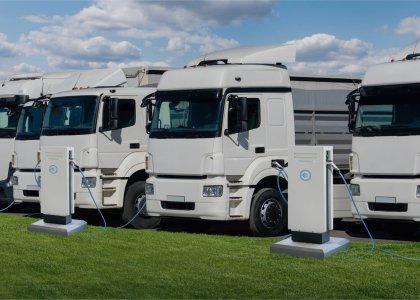Congress could finally be taking significant steps to address the climate impacts and numerous inequities of the transportation sector. The INVEST in America Act, set to be considered by the U.S. House’s Transportation and Infrastructure Committee today, would make greenhouse gas emissions and equitable transportation access key components of investment decisions.
Transportation is a fundamental driver of the U.S. economy, connecting people to job centers and services and improving the economic competitiveness of the country as a whole. It accounts for close to a third of greenhouse gas (GHG) emissions generated in the United States and has surpassed the electricity sector as the largest emitter in the country. People with low incomes and communities of color are disproportionately burdened by pollution from passenger and freight transportation, and they often face inadequate access to efficient and affordable mobility options. Previous transportation infrastructure packages paid very little attention to these environmental and equity challenges.
In addition to setting aside almost $4 billion dollars for electric vehicle charging infrastructure, the House’s $547 billion plan, introduced by Democratic leaders of the transportation committee on Friday, includes a series of key provisions that directs the U.S. Department of Transportation (DOT), states, and metropolitan planning organizations (MPO) to include GHG emissions and equity as considerations in transportation planning and for state and city projects. The reauthorization bill, focused on transportation funding, could be a key component of major infrastructure legislation this year. Including these provisions in a final bill is critical.
A range of strong provisions
The new bill increases funding and improves numerous requirements from the previous surface transportation reauthorization bill, introduced in the House in June 2020. Additionally, the INVEST bill is far better than a parallel Senate bill, advanced through committee in May, which includes very few provisions to tie transportation investments to environmental impact and equitable mobility access.
Of particular note, the House bill includes a requirement that DOT, in collaboration with the U.S. Environmental Protection Agency (EPA), establish performance measures that will help states evaluate the GHG emissions and mobility access impacts of their transportation systems. A similar performance measure was rolled back by the Trump administration in 2017 without notice. These performance measures will be vital to ensuring that states’ transportation investments will have net emissions reductions and will increase access to equitable, safe, reliable, and convenient transportation that connects people to jobs and services. The Senate bill includes similar language on measures to evaluate GHG impacts but does not consider transportation access as part of its performance measure requirements.
To support these efforts, INVEST requires states and the MPOs to incorporate the reduction of GHG emissions and localized pollutants and the improvement of mobility access in their transportation planning process. INVEST also pushes them to consider land use and housing policy through more holistic planning efforts.
The 2021 House bill keeps the two new climate-related programs that were included in the proposed 2020 language. The Carbon Pollution Reduction Program provide states with $8.3 billion over four years (2022–2025) to spend on transportation programs that are expected to reduce GHG emissions. The federal DOT would be required to monitor states’ progress and report on their emissions reductions. Local entities including MPOs, governments, and transit agencies, would also have $250 million available through competitive community climate innovation grants that prioritize projects that have the greatest emissions-reduction potential, while ensuring that they provide diverse transportation choices and improved accessibility, among other equity impacts. The Senate bill, by comparison, has approximately $6.4 billion for reducing GHG emissions from the transportation sector.
Key policies for freight planning
INVEST takes particular care to reduce GHG emissions from freight transportation and address inequitable air pollution from the sector, with provisions not included in the Senate bill. Domestic goods movement accounts for more than 30% of U.S. transportation CO2 emissions and is also a significant contributor to localized air pollution, which often disproportionately affects households with low incomes and communities of color. While electrifying freight vehicles will go a long way to addressing their emissions, improvements to the overall efficiency of the freight system will be equally necessary to making significant emissions reductions, improving the economy, and addressing congestion.
Of particular note, INVEST incorporates GHG and equity metrics into freight planning at the national and state levels. It expands the goals of the National Highway Freight Program (NHFP), a program that helps improve the efficient movement of freight on U.S. roads. The bill would ensure, for the first time, that the program incorporates greenhouse gas emissions, local air pollution, and impact on local communities located near freight facilities as part of its goals. Therefore, funding distributed to states through the NHFP would be required to go toward activities that significantly reduce GHG emissions, local pollution, and inequities. In tandem, this provision removes an outdated limit on the share of funding that can go to projects that facilitate multimodal goods movement, such as investments in intermodal facilities. Such projects could be funded as long as they deliver public benefits, which would provide an additional incentive to states and cities to invest in projects that maximize the use of more efficient rail, water, and intermodal freight facilities. The Senate bill includes none of the environmental and equity provisions for freight and keeps the multimodal funding cap in place, though increasing it to 30% from the current limit of 10%.
Under INVEST, states will not be eligible for general freight funding unless they have developed state freight plans that include consideration of environmental and equity impacts. This is necessary because ACEEE has found that most state freight plans today do not consider these impacts. This provision and the ones described above are in line with recommendations ACEEE provided in a review of state freight plans last year to further state and federal efforts to incorporate GHG emissions reductions into freight planning. The bill also includes similar requirements for the National Multimodal Freight Policy and the National Freight Strategic Plan, both of which have great potential for advancing system efficiency in the freight sector.
Other important freight provisions in the bill include the creation of the Gridlock Reduction Grant Program and reauthorization of the national cooperative multimodal freight research program for the first time since fiscal year 2009. INVEST funds the grant program at $500 million (double the amount from last year’s bill) and dedicates 50% to freight-specific projects in large urban areas that use innovative and technology-enabled first- and last-mile delivery solutions, curb space pricing and management efforts, and real-time freight parking and routing. This grant program will be supported by the research program’s work on the impact of freight on the environment and technological solutions to improve goods movement.
Each of the elements described above will be crucial for creating a reauthorization bill that ensures that transportation infrastructure is funded in a manner that reduces carbon emissions and dramatically improves the equity of our mobility systems.



